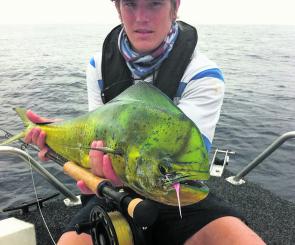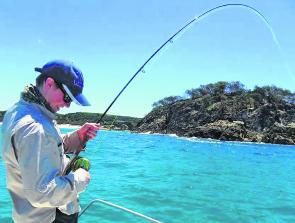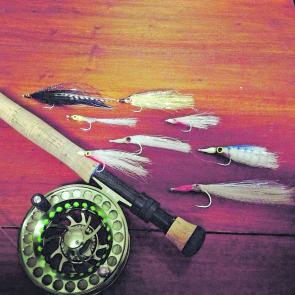In the final instalment of this three-part series, I’ll be discussing the thick end of fly fishing by focussing in on saltwater fly fishing and dealing with heavy tackle.
Fly fishing with heavy tackle for me is a lot of things. It’s chaotic, challenging and heart-breaking at times, but most of all its rewarding. Subduing big fish on fly tackle is a real feat and probably worth 10 on a lure – it is for me anyway.
It should be stressed that gearing up for this type of fly fishing is usually a bit more expensive, and care needs to be taken in the preparation stage. Fly fishing with heavy tackle is pretty different to using the lighter gear I’ve talked about in the last 2 parts of this series.
But it’s not all pain and anger. Once you get going, big ocean-going speedsters and inshore behemoths can quite easily be switched onto a fly when you get your presentation right. I’ve watched fly tackle out fish conventional tackle inshore and offshore with big fish plenty of times, and like I’ve said before, it’s no accident.
With saltwater fly fishing, the most important part of your set up is your reel. Important features are a spool that facilitates high line capacity, a fairly heavy and smooth drag, and while helpful but not necessary, a large arbor.
Rods should be tailored to the application they’re intended to undergo, and I think a fly angler’s definition of ‘heavy’ will depend on where he or she is fishing!
Lines sit in a similar basket – selected in accordance. For distance casting, some anglers opt for something known as a shooting head. A shooting head is approximately 20ft long, and is attached to your fly line. It’s much heavier than normal fly line. Basically, it’s like a 20ft sinker! Personally, I find them a hindrance to my fishing. They’re very taxing to cast all day and hard to pick up to make another cast, but some anglers use them with great success.
Backing on your reel is very important, as within most fly fishing for pelagic species, they will strip you well into it. To be safe, my two saltwater set ups (an 8wt and a 10-11wt) both have around 300m of backing, which connects to the fly line with a bimini twist.
Selecting flies for big fish can be a lot of fun. Generally, it’s an easier task than it is with trout, for example, where everything needs to sit just right. Usually, we’re targeting creatures that attack baitfish and other small morsels at speed, so anything palm-sized and shiny is a good all-rounder.
In specific cases, where more selective and pressured fish are concerned, specialized presentations are preferred. In some scenarios, anglers use flies to imitate crabs, shrimp, micro bait, and even algae, weed or bread!
One of my favourite things about bigger flies is that they are easier to tie, as I’m very keen but not overly skilled in that department! For tiers out there targeting high-speed predators, one recommendation I have is to try tying with Gamakatsu’s SL12S range of saltwater fly hooks. Nothing gets that beautiful corner of the jaw hook-up like an SL12S and they come razor-sharp out of the packet. People trolling baits for marlin have started using them to rig their baits because of how well they hook bony-jawed fish!
Keep in mind that larger flies can be more difficult to cast, as the can material picks up water and can create drag in the air.
Double hauling is a casting technique that aids in distance casting and casting larger flies.
A haul is simply pulling back against the fly line your holding with your non-casting hand during the casting stroke (away from the reel). This facilitates casting efficiency by loading and bending the rod deeper. A double haul is pulling the fly line on the forward and backward stoke of the cast.
Double hauling will make casting big flies a reasonable distance more efficient, and you’ll be able to shoot a lot more line. Double hauling is almost compulsory when approaching feeding fish from a distance, as often you can’t get too close, or the fish will spook.
The Double-handed retrieve, or double-handed stripping, is a means of generating a faster retrieve for pelagic species, or even imparting a slow, steady and subtle retrieve without jerks.
For double-handed stripping, you quite simply put the rod handle under your armpit, and using both hands in quick succession, rip the line through the guides.
A great thing about this technique is that when a fish takes the fly, the angler is unable to lift the rod, meaning the hook sets well in the fish’s jaw. Taking the rod out from under your arm and adopting the usual fighting stance once connected can be a bit of a scramble, but the chaos is half the fun of saltwater fly fishing.
Strip-striking
While I covered this in the previous issue, it’s probably even more important in this style of fly fishing. Often, pelagics will have very hard, bony jaws and a solid strip-strike, with the rod pointed directly at the fish, will do a world of good before a lengthy battle on the fly rod. Strip-striking is also important for implosion feeding species such as barra, that can reject a fly in a fraction of a second, as you can put more pressure through the line very quickly.
When using the double-handed stripping technique mentioned above, the hook-up will happen automatically, but when using a normal tripping technique, just remember to keep your rod down.
In some instances, anglers fishing fly for big GTs and other giants on the flats will run backwards as they strip-strike just to make sure that hook point finds its penetration, but usually this isn’t necessary.
When you’ve locked horns with a hard-running speedster, the first thing it will want to do is take you on a tour of the ocean… Clearing your line is very simple, but very important to know.
Once the fish is hooked, use your stripping hand and hold the fly line away from the reel and rod handle and allow the fish to take up the slack in its run. Doing this will ensures that the line doesn’t catch on anything and you’re then able to use the reel to battle the fish.
Having some awareness when doing this goes a long way. On one occasion, I was sight-casting to big kingfish and upon hook-up with a metre-plus model, and my lack of awareness resulted in a big stuff up! Once I’d strip-struck, the kingie headed back for the reef. As the line flew up in the air like spaghetti, a loop went and wrapped around a cleat on the deck of the boat, and another went around my neck… To cut a long story short, I lost the fish and the fly, damaged the fly line and I had a sore neck, all because I didn’t check my surroundings before making the cast.
A famous person in the fly fishing community once said that if you want to take up saltwater fly fishing, the first thing to practise is your winding. This couldn’t be any truer.
Big fish will run very quickly away from you once hooked, but sometimes they come back at you just as fast, and it’s important to take up that slack as quickly as you can.
It’s imperative that you’re doing the winding with your dominant hand, because they’ll be a lot of cranks involved with the 1:1 wind ratio fly reel!
Big fish can be fought by hand, particularly around structure – Rod Harrison proved this many years ago with black bass in Papua New Guinea. You need to have a firm grip of the line and absorb the lunges of the fish with the rod and your body to make up for no line being given.
The same principle applies when a fish comes back toward you and you’re fighting it by hand – you need to take up that slack!
When fighting fish, your long fly rod can be used a tool to tire fish out quicker, stop them from getting you into trouble, and win you that battle.
When big fish come close to the boat, some anglers like to apply pressure in the opposite direction to the way the fish lunges, and this puts strain on the fish and wears the fish out faster.
Another trick commonly use around structure and fast flowing water, is to apply pressure from the side. When this is done successfully, the fish will run in the opposite direction to the direction the pressure is being applied, or in the desired direction, which is normally up current, away from snags, away from other feeding fish etc.
In shallow water, you can pull the rod down toward the ground as the fish runs away from you. What this will do is pull the fish’s head into the bottom and stand the fish on its head, disrupting its swimming pattern. This makes controlling the fish much easier and will help you to win the fight with stubborn fiish.
With heavy tackle fly fishing, you can really appreciate every fish, as even some of the smaller fish feel big! While it can be difficult to firstly find the gear at a good price, and then set up the rig, find a place to use it and finally land big angry fish on a noodle with guides, the effort invested is definitely worth it.
With all the trouble you go through getting everything prepared, you might even discover that a nice seductively-worked fly out fishes you mate’s noisy popper on pelagics, and then he’ll want to give it a go too! It’s happened to me…
There’s saltwater fly options Australia wide all year round, and I believe many people aren’t taking advantage of what great species this country offers us on a platter.
So get out there, take the fly rod… and get bent!
Reads: 1470
Mahimahi are a great starting point for anyone keen to get into saltwater fly fishing – the fight is phenomenal and when schooled up, they can be forgiving of sloppy presentation and in the author’s case… sea sickness.

Kingfish will beat you up on any tackle, and are a real challenge to land on fly. This kingfish of about 90cm took a home-tied garfish pattern in about 2.5m of water – it doesn’t much more exciting than that!

Into the backing and loving it! A solid kingfish makes its way back toward the headland as the author tries to get back some precious line.

On the inshore side of things, threadfin salmon are a solid adversary on heavier fly tackle.

A perfect hook up. When any fish is hooked in the hard part of the jaw’s corner, the hook will rarely pull or be shaken out. The SL12S hook found the corner perfectly for this thready.

The author’s kit of rough home-tied flies saved for offshore trips and big estuarine predators.




